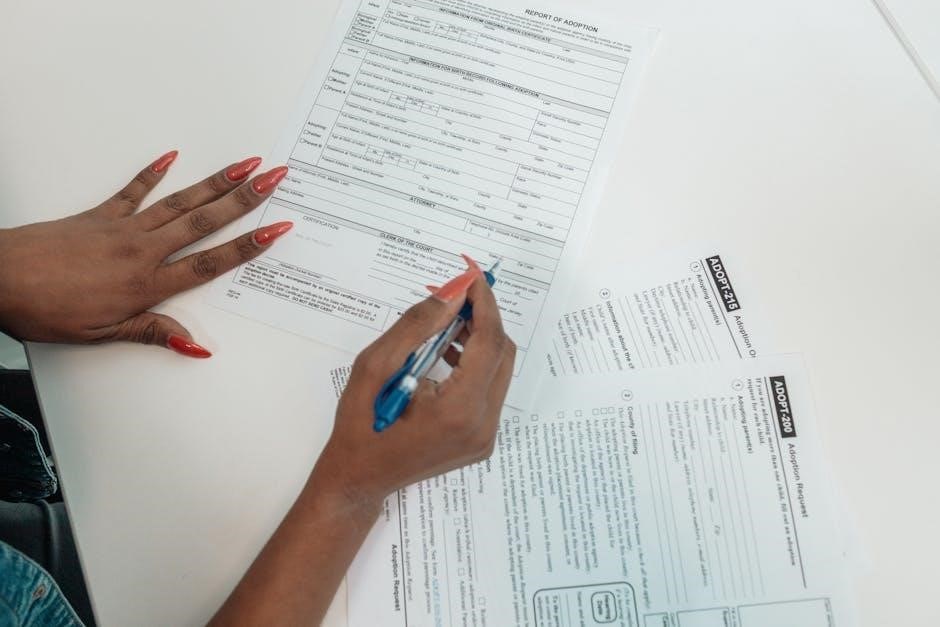The Ontario Residential Rental Application Form 410 is a standardized document used by landlords to evaluate potential tenants. Created by the Ontario Real Estate Association (OREA), it collects detailed information about applicants, including their personal, financial, and rental history. This form is essential for landlords to assess credibility and suitability for tenancy, ensuring a smooth rental process.
Form 410, known as the Ontario Residential Rental Application Form, is a standardized document designed to facilitate the rental application process. Created by the Ontario Real Estate Association (OREA), this form is widely used by landlords and property managers to assess potential tenants. It collects essential information about applicants, including personal details, rental history, employment, and financial status. The form helps landlords evaluate an applicant’s credibility and suitability for a tenancy. By providing a structured format, Form 410 ensures that all necessary information is gathered efficiently, aiding landlords in making informed decisions. It is a crucial tool in the tenant screening process, promoting transparency, fairness, and efficiency for both parties involved in the rental process.
Purpose of the Form
Form 410 serves as a comprehensive tool for landlords to evaluate potential tenants in Ontario. Its primary purpose is to collect essential information about applicants, enabling landlords to assess their suitability for a rental property. The form gathers details about an applicant’s personal history, employment, financial status, and previous rental experiences. This information helps landlords determine the applicant’s credibility and reliability as a tenant. By standardizing the rental application process, Form 410 ensures that landlords can make informed decisions fairly and efficiently. It also provides a clear framework for tenants to present their qualifications, promoting transparency and mutual understanding between both parties. This form is a vital component of the tenant screening process in Ontario.
Importance of Form 410 in Rental Applications
Form 410 plays a crucial role in Ontario’s rental application process by providing a standardized method for landlords to evaluate potential tenants; Its importance lies in its ability to streamline the tenant screening process, ensuring that landlords gather all necessary information efficiently. This form helps landlords assess an applicant’s financial stability, rental history, and personal background, reducing the risk of selecting unreliable tenants. For tenants, Form 410 offers a structured way to present their qualifications, demonstrating their credibility and responsibility. By facilitating a fair and transparent evaluation process, Form 410 protects the interests of both landlords and tenants, fostering a positive rental relationship. Its widespread use has made it an essential document in Ontario’s rental market.

Key Sections of Form 410
Form 410 is divided into six main sections, covering applicant information, rental history, employment details, banking information, vehicle and personal details, and signatures. These sections ensure comprehensive tenant evaluation.
Section 1: Applicant Information
Section 1 requires applicants to provide personal details such as full name, date of birth, current address, and contact information. This section also asks for a driver’s license number and Social Insurance Number (SIN) to facilitate background and credit checks. Applicants must list all occupants, including their relationship to the applicant. This information helps landlords verify identity and assess the suitability of potential tenants. Accurate completion of this section is crucial for a smooth rental application process. Landlords use this data to conduct thorough screenings, ensuring they make informed decisions about tenancy.
Section 2: Rental History
Section 2 focuses on the applicant’s rental history, requiring details about current and previous residences. Applicants must list addresses, rental periods, monthly rent amounts, and landlord contact information. This section also asks for the reason for leaving previous properties and whether they provided proper notice. Additionally, applicants may need to explain any evictions or legal disputes related to tenancy. This information helps landlords assess the applicant’s reliability and rental behavior. Providing accurate and complete rental history is crucial, as it influences the landlord’s decision to approve or deny the application. Incomplete or misleading information may lead to rejection.
Section 3: Employment and Income Details
Section 3 of Form 410 focuses on the applicant’s employment and income details, which are critical for assessing their financial stability. Applicants must provide their employer’s name, address, and contact information, along with their job title, length of employment, and monthly gross income. Self-employed individuals may need to supply additional documentation, such as financial statements or tax returns. This section also asks about other sources of income, such as investments or government benefits. Accurate disclosure of income is essential, as it helps landlords evaluate the applicant’s ability to meet rental payments. Incomplete or misleading information may result in the application being denied. Providing proof of employment and income, such as pay stubs or letters from employers, is often required to support the information provided in this section. This ensures transparency and builds trust between the applicant and landlord.
Section 4: Banking and Financial Information
Section 4 of Form 410 requests detailed banking and financial information to assess the applicant’s financial stability. It typically asks for bank account numbers, account types (e.g., checking or savings), and recent transaction history. Applicants may also need to provide information about other financial assets, such as investments or savings accounts. This section helps landlords evaluate the applicant’s ability to manage rent payments consistently. Additionally, it may inquire about any past financial issues, such as account closures or bankruptcies, to understand potential risks. Providing accurate and complete banking information is crucial, as it plays a significant role in the landlord’s decision-making process. Supporting documents, like bank statements, are often required to verify the details provided in this section.
Section 5: Vehicle and Personal Details
Section 5 of Form 410 collects vehicle and personal details to provide additional context about the applicant. It typically includes fields for vehicle ownership, make, model, year, and license plate number. This information helps landlords assess potential property wear and tear or parking needs. Personal details may encompass marital status, number of dependents, and emergency contacts. Some applications also ask for a driver’s license number for identity verification. While this section is less financially focused than others, it contributes to a comprehensive tenant profile. Applicants should ensure all information is accurate and complete to avoid delays in the approval process. This section is a standard part of the evaluation process, aiding landlords in making informed decisions about tenancy.

Section 6: Declaration and Signatures

Section 6 of Form 410 requires applicants to sign and date the document, confirming the accuracy of the information provided. This declaration is a legal affirmation that all details in the application are true and complete. Applicants must certify that they have read and understood the terms of the application process. In some cases, co-applicants or guarantors may also need to sign. The signature serves as a binding confirmation of the applicant’s intent to rent the property if approved. Landlords rely on this section to verify the legitimacy of the application and ensure compliance with rental procedures. It is essential for applicants to review all information carefully before signing, as false statements may lead to rejection or legal consequences.

Required Documentation
Required documentation for Form 410 includes identification, proof of employment, bank statements, and rental history. These documents help landlords assess an applicant’s credibility and financial stability.
Identification Documents
Identification documents are crucial for verifying an applicant’s identity. Commonly required documents include a valid government-issued ID, driver’s license, passport, or permanent resident card. Additionally, landlords may request a Social Insurance Number (SIN) for credit checks. Applicants should provide photocopies of these documents to ensure authenticity. Proper identification helps landlords assess the applicant’s credibility and comply with legal requirements. Ensuring all ID documents are up-to-date and valid is essential for a smooth rental application process. These documents play a key role in establishing trust and verifying the information provided in Form 410.
Proof of Employment and Income
Proof of employment and income is essential for landlords to assess an applicant’s financial stability. Commonly required documents include recent pay stubs, employment letters, and tax returns. These documents verify the applicant’s income source, consistency, and amount. Landlords may also request a Notice of Assessment from the Canada Revenue Agency (CRA) for additional verification. Self-employed individuals should provide financial statements or business tax returns. This information helps landlords evaluate the applicant’s ability to pay rent consistently. Providing accurate and up-to-date proof of income ensures a smoother rental application process and builds trust with the landlord. It is crucial to include all relevant financial details to strengthen the application.
Bank Statements and Financial Records
Bank statements and financial records are critical for verifying an applicant’s financial stability and creditworthiness. Landlords typically request recent bank statements to review the applicant’s account balance, transaction history, and financial behavior. This helps assess their ability to manage rent payments consistently. Applicants may also be asked to provide details such as their bank account numbers and routing information. Additional financial records, like investment accounts or retirement funds, may be requested to further evaluate financial health. Providing accurate and up-to-date bank statements ensures transparency and strengthens the rental application. This documentation is essential for landlords to make informed decisions about tenant suitability and financial reliability.
Rental History and References
Rental history and references are vital components of the Form 410, as they provide insight into an applicant’s past tenancy behavior. Applicants are typically required to list previous landlords or property managers, along with their contact information and the addresses of properties they’ve rented. This section helps landlords assess the applicant’s reliability and responsibility as a tenant. Providing accurate and detailed rental history demonstrates transparency and trustworthiness. Additionally, applicants may be asked to furnish references from previous landlords or rental agencies to verify their tenancy record. Ensuring this information is complete and accurate is crucial, as it directly impacts the landlord’s decision-making process. A positive rental history and strong references significantly enhance an applicant’s chances of approval.

Filling Out the Form
Form 410 requires detailed personal, financial, and rental history information. It starts with property address, move-in date, and rent amount, followed by applicant details and signatures.
How to Access Form 410
Form 410, the Ontario Residential Rental Application, can be accessed through the Ontario Real Estate Association (OREA) website or obtained from licensed realtors or property managers. It is available for download as a PDF or printable document, making it easy for applicants to complete and submit. Additionally, some landlords or property management companies may provide the form directly to prospective tenants. The form is free to use and widely recognized across Ontario as a standardized tool for rental applications. Applicants can also fill it out electronically and submit it online, depending on the landlord’s preferences. Ensuring accuracy and completeness is crucial when filling out the form.

Step-by-Step Guide to Completing the Form
Start by reviewing the form and gathering all necessary documents. Begin with Section 1, providing accurate personal and contact information. Move to Section 2, detailing your rental history, including past addresses and landlord contacts. In Section 3, disclose your employment and income details, ensuring to include all sources of income. Section 4 requires banking and financial information, so have your account details ready. Section 5 asks for vehicle and personal details, such as license plate numbers. Finally, Section 6 requires a declaration and signature, confirming the accuracy of the information provided. Attach any required documentation and review the form thoroughly before submitting it to the landlord or property manager.
Reviewing and Signing the Application
Before signing, carefully review each section to ensure all information is accurate and complete. Verify that personal details, rental history, employment data, and banking information are correct. Check that all required documentation, such as identification and proof of income, is attached. Understand that providing false information can lead to rejection or legal consequences. Once satisfied, sign and date the application, confirming the accuracy of the submitted details. Be aware that signing the form grants the landlord permission to conduct credit and reference checks. Keep a copy of the completed application for your records. Ensure you understand the terms and implications before finalizing the submission to the landlord or property manager.

Ontario Rental Laws and Regulations
Ontario’s rental laws are governed by the Residential Tenancies Act (RTA), which outlines tenant and landlord rights, security deposits, rent increases, and eviction processes, ensuring fair housing practices province-wide.
Residential Tenancies Act (RTA) Overview
The Residential Tenancies Act (RTA) is the primary legislation governing rental agreements in Ontario. It outlines the rights and responsibilities of both tenants and landlords, ensuring fair and legal rental practices. The RTA covers key areas such as security deposits, rent increases, eviction processes, and the maintenance of rental properties. It also establishes the Landlord and Tenant Board to resolve disputes. Tenants are protected from unlawful evictions and unreasonable rent hikes, while landlords are assured of timely rent payments and property upkeep. The RTA applies to most residential tenancies, fostering a balanced and regulated rental environment across Ontario.
Legal Rights and Responsibilities of Tenants
Tenants in Ontario have legal rights under the Residential Tenancies Act (RTA), including the right to a safe and habitable living environment. They are entitled to privacy, protection against illegal evictions, and timely repairs by landlords. Tenants must pay rent on time, maintain the rental unit, and comply with lease terms. They are responsible for avoiding damage to the property and ensuring their actions do not disturb others. Tenants are also required to provide proper notice before moving out. Understanding these rights and responsibilities is crucial for fostering positive tenant-landlord relationships and ensuring compliance with Ontario rental laws. Tenants should familiarize themselves with the RTA to navigate any disputes or issues effectively.
Landlord Obligations Under the RTA
Under the Residential Tenancies Act (RTA), landlords in Ontario are required to maintain the rental property in a safe and habitable condition. This includes ensuring all vital services like heat, water, and electricity are functional. Landlords must address necessary repairs promptly and comply with all health and safety standards. They must also respect tenants’ privacy, providing at least 24 hours’ written notice before entering the unit. Landlords are prohibited from illegal actions such as locking out tenants or seizing their belongings. Additionally, they must follow legal eviction processes and provide tenants with a written lease agreement. Failure to meet these obligations can result in penalties and legal action, ensuring tenants’ rights are protected under Ontario law. Landlords must act fairly and transparently in all dealings with tenants.

Tips for Applicants
Applicants should ensure all information is accurate and complete to avoid delays. Providing required documentation promptly can improve approval chances. Reviewing the application before submission is essential to avoid errors and ensure clarity, helping landlords assess credibility effectively. Being transparent and prepared demonstrates responsibility, increasing the likelihood of a successful rental application. Organize financial and personal records in advance to streamline the process. Attention to detail and professionalism in the application can make a positive impression on landlords. This thorough approach helps build trust and may lead to a smoother tenancy experience for both parties. Being proactive and organized is key to a successful application.
How to Increase Your Chances of Approval

To enhance your chances of approval for a rental application using Form 410, ensure all information is accurate and complete. Provide required documentation promptly, such as proof of employment, bank statements, and rental history, to demonstrate responsibility. Review the application thoroughly to avoid errors and omissions. Being transparent about your financial situation and rental history builds trust with landlords. Consider including a cover letter to introduce yourself and explain your interest in the property. Highlighting stable income, a good credit score, and positive references from previous landlords can make your application stand out. Being prepared with references and maintaining a good credit score also improves credibility. Professional presentation and following up politely can leave a positive impression, showing enthusiasm and professionalism.
Common Mistakes to Avoid
When completing Form 410, avoid common mistakes that could delay or hinder approval. Ensure all sections are filled out fully and accurately, as incomplete applications may lead to rejection. Providing false or misleading information can result in disqualification. Avoid submitting applications without required documentation, such as proof of income or rental history. Do not disclose unnecessary personal details, like bank account numbers, before verifying the landlord’s legitimacy. Failing to review the application for errors or omissions can also harm your chances. Additionally, avoid neglecting to include references or failing to address past rental issues upfront. Being dishonest or evasive about financial stability or rental history can raise red flags. Ensure transparency and accuracy to build trust with landlords.

